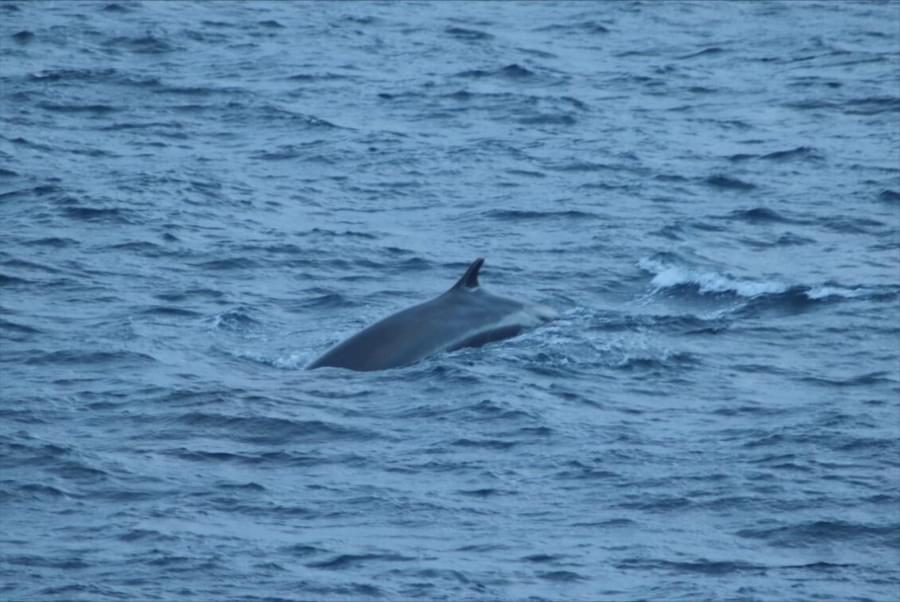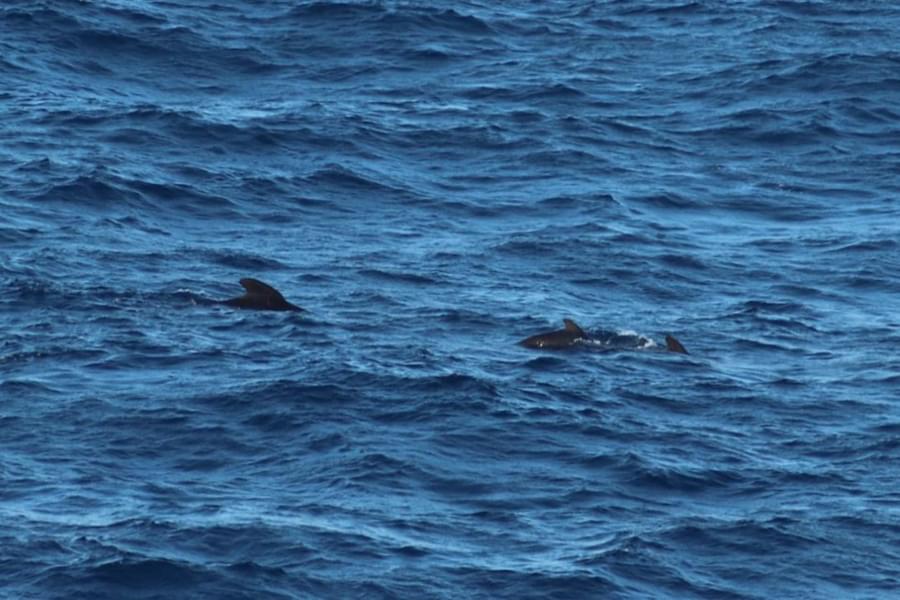Ocean Conservationist Maria tells us about her final rotation on the Brittany Ferries’ Galicia.
With the summer season in full swing, the past three weeks on board have been filled with sunshine, enthusiastic passengers and lots of great sightings.
As usual, common dolphins were the cetacean that we encountered most frequently. This time around, however, we saw several pods containing mother-calf pairs, which was super exciting for all of us on board. Common dolphin calves, which are born between May and September, are easy to spot because they are about half the size of an adult and will closely mimic the mother’s movement.
Watching common dolphins leap so freely out of the water (they can jump 6 metres high if they want to!), it is hard to believe that thousands are caught as bycatch in the Bay of Biscay every year. Not only is data collected by ORCA’s citizen scientists important for monitoring how cetacean populations respond to threats such as this, but ORCA also works to address bycatch at both a UK and European level through membership of groups such as ASCOBANS (Agreement on the Conservation of Small Cetaceans of the Baltic, North East Atlantic, Irish and North Seas). In the UK, ORCA and other NGOs are urging the government to set more ambitious targets for reducing bycatch.

Another species that commonly falls victim to bycatch is the harbour porpoise, the smallest but most numerous cetacean in UK and European waters. During this rotation, I encountered harbour porpoises on two occasions (a first for me!), exhibiting their characteristic forward rolling motion through the water.
“How can you tell the difference between a dolphin and a porpoise?” is a question I am asked frequently. Other than the fact harbour porpoises are comparatively smaller and have different colouration, the key thing to look for is the dorsal fin. Dolphins have a more pointed, swept-back dorsal fin, whereas the dorsal fin of a harbour porpoise is smaller and shaped like an equilateral triangle.
Whilst harbour porpoises are the smallest cetacean in UK and European waters, we also had many sightings at the other end of the spectrum. Fin whales, which are the second largest species of whale and can grow to a length of 27 metres, were the whale species we encountered most often. The number of fin whales in the Bay of Biscay increases during the summer months when they come into the area to feed, peaking in August. A key identification feature of fin whales is their asymmetrical jaw colouration – their lower right jaw is white, whereas their lower left jaw is grey. The other feature to look for is their swept-back, hooked dorsal fin, which can be 60cm in height!

Fin whale numbers were decimated during the peak of commercial whaling, and although the global population is increasing, their numbers are still a fraction of what they used to be (the species is listed as vulnerable by the IUCN). In the Bay of Biscay, where an estimated 8,000 individuals can be found, a major threat to fin whales is ship strike. Ship strike is defined as a forceful impact between any part of a watercraft, most commonly the bow or propeller, and a live cetacean, often resulting in death, major injuries or physical trauma. The Bay of Biscay is considered a hot spot for ship strike due to the large numbers of fin whales and high levels of shipping traffic. ORCA has been working to address ship strike in several ways, including the production of a ship strike toolkit and delivering ship strike mitigation training to ship crews.
One of my favourite species, and one we were lucky enough to encounter several times, is the pilot whale. Pilot whales are actually members of the dolphin family, and they get their name from the old theory that they followed a leader or ‘pilot’. This squid-eating species frequently feeds at night, and so they are often seen resting during the day, which makes for great viewing! The key identification feature of pilot whales is their dorsal fin – it is positioned towards their head, rather than being central, and has a distinctive hooked shape. The dorsal fins are particularly wide-based and hooked in older males.

There are two species of pilot whale, the short-finned pilot whale and the long-finned pilot whale. The main distinguishing feature of these two species is the relative length and shape of their pectoral fins, which makes it virtually impossible to tell them apart at sea! As the range of these two species overlaps in the Bay of Biscay, all the pilot whales we saw had to be recorded as ‘unidentified pilot whales’ in the OceanWatchers app. Recording sightings in the OceanWatchers app enables ORCA to continue to carry out vital monitoring in the Bay of Biscay, which is crucial to the long-term conservation of cetaceans and their habitats.
My time spent on board the Galicia this summer has been unforgettable, and I am so grateful to have had this experience. The Bay of Biscay is a truly remarkable place, and, although I have to say goodbye, for now, I hope to be back soon!
Ocean Conservationist Maria (Bay of Biscay)

